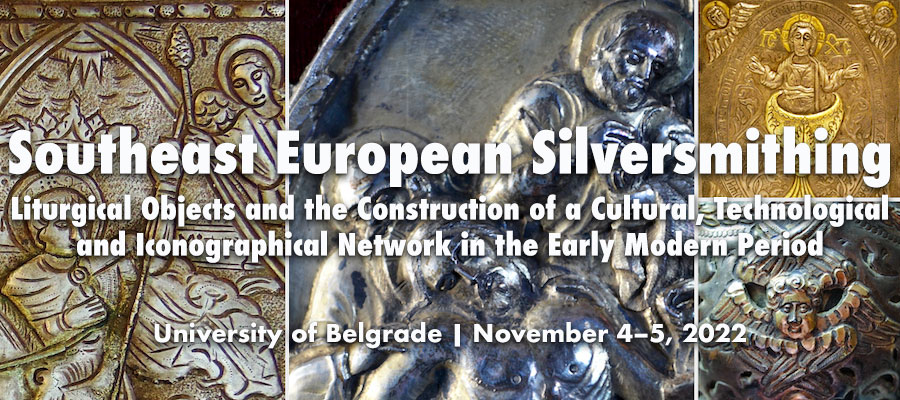Southeast European Silversmithing: Liturgical Objects and the Construction of a Cultural, Technological and Iconographical Network in the Early Modern Period, University of Belgrade, November 4–5, 2022
The conference on Southeast European Silversmithing: Liturgical Objects and the Construction of a Cultural, Technological and Iconographical Network in the Early Modern Period aims to gather researchers dedicated to the study of sacral silver objects from the early modern period who will, through their research and works, contribute to the comparative analysis of this complex field. Material presented at the conference will contribute to the objective of improving methodological means of interpretation through the gathering of devoted researchers working in this area. The conference will enable the presentation of thus far unpublished and unknown to the academic community artistic silver objects. We believe that a more meticulous approach to this field of research will represent a valuable contribution to the field of art history, and to a more comprehensive understanding of the visual culture of the specified period.
The conference is scheduled to take place on 4th-5th November 2022. Due to the ongoing epidemiological situation, postponement until Spring 2023 is possible. The conference will be held at the Faculty of Philosophy, University of Belgrade, with the option of remote participation online.
The aim of the conference is to gather scholars dedicated to the study of liturgical objects made from precious metals produced in the early modern period, approximately from 1450s to 1850s. We are inviting submissions of papers dealing with the cultural roots of the artistic shaping of objects, the technological possibilities of their production, and the iconographical themes and motifs present on them. Besides these main themes, we welcome proposals which reveal the specificity of southeast European silversmithing centers, or artistic centers connected with liturgical objects kept in church and monastery treasuries and museum collections in the region. Academic research on relics and their presence in reliquaries of different types will also be considered. Also significant is research on the production of silver reliquaries and reliquary boxes and their role in contributing to the dissemination of saintly cults. Furthermore, suggested topics include the phenomenon of popular piety, particularly the practice of the production and offering of different votive gifts (Ex voto) and the making of silver fittings for Orthodox icons. We welcome studies emerging from the methodological approach of contextualization, which will encourage interpretations of social, political and ideological issues that influenced the artistic shaping and decoration of sacral silver objects. Lastly, one of the aims of the conference is to collect the hallmarks of silversmiths and goldsmiths from the region and to consolidate ways of hallmarking and measuring the purity or fineness of silver alloys, as well as of their attribution to specific silversmiths and their workshops in southeastern Europe.
While the conference is aimed at combining the expertise of scholars dedicated to the study of diverse cultural and religious areas and periods, we especially encourage submissions of papers focusing on the following topics:
- The role of sacral silver in the transfer and dialogue between different cultural models.
- Technological exchange and the characteristics of production of liturgical and sacral silver on the territory of southeastern Europe.
- Iconography, the transfer of iconographical themes and motifs, and the characteristics of symbolic decorations of liturgical silver on the territory of southeastern Europe.
- The stylistic development and periodization of silver objects made in southeastern Europe.
- “Secondary decoration”: geometric and natural motifs as a universal pictorial language in southeast European silversmithing.
- The cult of relics, their veneration and the use and production of silver reliquaries and reliquary boxes.
- Popular piety in southeastern Europe: Ex voto and fittings on icons.
- Sacral silver and comparative religious practices of Christians, Jews and Muslims in southeastern Europe.
- Engraved inscriptions on sacral silver objects: from historical sources to private-public liturgical memory.
- Social, political and ideological phenomena as factors influencing the shape and decoration of silver liturgical objects.
- Hallmarking and control of silver purity and fineness, and the hallmarks of master craftsmen and their workshops on the territory of southeastern Europe.
The conference will be held entirely in English.
